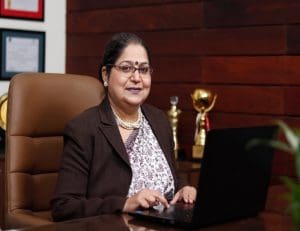By Ms. Poonam Kumar Mendiratta
Principal – The Manthan School

Assessment is an integral part of instruction, as it determines whether or not the goals of education are being achieved. Assessments help to make educational decisions about students, to give feedback about his or her progress, strengths and weaknesses. They are also an instrument to judge the effectiveness and curricular adequacies. They inspire us to ask these hard questions: “Are we teaching what we think we are teaching?” “Are students learning what they are supposed to be learning?” “Is there a way to teach the subject better, thereby promoting better learning? The assessment procedures relate to authenticity, practicality, reliability and validity. The utmost value of these principals should be to distinguish the effects of assessment and review any classroom-based issues between the teacher and the student.
As per the traditional methods, we often picture students shuffling through the papers for their tests. What they are required to do is to write short answers, respond to multiple-choice questions, or write answers in brief. As a result, the entire focus of the students is to search their memories for appropriate responses and apply formulae to the problem. Today’s 21st-century learners require skills that will allow them to face an ever-changing world besides basic reading and numeracy skills. They must be able to think critically, analyze, and make inferences. Our students need new learning goals for which the teacher needs to take an active role to establish a balance between the purpose of assessment and the content that is being assessed.
A vast shift in assessments needs to be explored, instead of pen and paper to performance assessment, the single correct answer to many correct answers, summative to formative, outcome only to process and outcome, skill-focused to task-based and isolated facts to the application of knowledge. For example, if I have to test the grammar concepts taught to the learners, I can easily ask them to write a narrative. This type of assessment will be a task-based assessment. The teachers need to create various possibilities and opportunities to formulate assessments that support the development of metacognition. They also provide a kind of self-awareness required to become a better learner and develop higher-order skills and dispositions. There is a crucial distinction between assessment of learning and assessment for learning. Stressed should be laid on the latter, as teachers who assess in this way are concerned not just to confirm and verify what their students have learned, but also to help their students and themselves understand what the next steps in learning should be and how to attempt them.
Today, we know learning requires the learner to engage actively in problem-solving activities to build their mental models. Knowledge is attained not just by receiving information, but also by interpreting and relating it to the knowledge base. In the words of Grant Wiggins “Assessment should be deliberately designed to improve and educate student performance, not merely to audit as most school tests currently do.” Assessments can be authentic and alternative only when they measure what is important in the curriculum. They should look more like instructional activities than like tests to gauge student’s understanding of the material. Examples of these measurements are open-ended questions, written compositions, oral presentations, projects, experiments, and portfolios of student work. Now is the time for a paradigm shift in taking assessments and enhancing the 21st-century skills of our learners.


